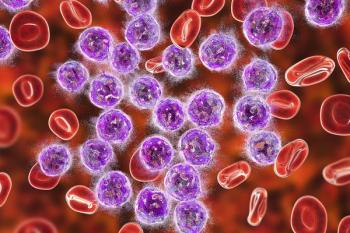
Trial Suggests Imatinib Discontinuation Safe, Some Responses Persist
Evidence continues to mount that discontinuing imatinib treatment for chronic myeloid leukemia (CML) in the chronic phase is safe. A new phase II Dutch and Belgian study showed only about two-thirds of patients relapsed after discontinuing treatment with imatinib and cytarabine, and all patients remained sensitive to imatinib after relapse.
Evidence continues to mount that discontinuing imatinib treatment for chronic myeloid leukemia (CML) in the chronic phase is safe. A new phase II Dutch and Belgian study showed only about two-thirds of patients relapsed after discontinuing treatment with imatinib and cytarabine, and all patients remained sensitive to imatinib after relapse.
Tyrosine kinase inhibitors including imatinib have revolutionized CML treatment in recent years, but the need to continue treatment indefinitely is limiting. Several recent studies have begun to suggest that
After a median follow-up period of 36 months, three patients randomized to continue treatment (17%) and 10 patients in the discontinuation arm (67%) had a molecular relapse; all three of the former patients had stopped imatinib treatment after randomization.
The molecular relapse rate at 12 months was 0% in the continued therapy group and 53% in the discontinuation group; at 24 months, those rates were 6% and 67%. In an as-treated analysis (accounting for the patients who ceased treatment in spite of randomization to continue imatinib), the two-year rate was 61% for discontinued therapy and 0% for continued imatinib.
The five patients in the discontinuation group who did not relapse showed a stable molecular response. The 13 patients who relapsed all regained molecular response after a median of 6 months from the restart of imatinib or nilotinib treatment.
“To our knowledge, this is the first randomized trial regarding the discontinuation of imatinib in first chronic phase CML patients who have achieved a durable and stable molecular response,” the authors wrote. “Our results are encouraging.” They noted that the addition of cytarabine to the initial regimen may have contributed to the persistence of response after therapy discontinuation, but that remains unclear.
Further studies on this issue will need to define predictive factors for successful discontinuation of imatinib, as well as of other TKIs including nilotinib and dasatinib, the researchers wrote. “Although imatinib treatment was previously expected to be life-long, our data suggest that, under close PCR monitoring, discontinuation of imatinib is safe in CML patients with a long-lasting molecular response,” they concluded.
Newsletter
Stay up to date on recent advances in the multidisciplinary approach to cancer.
































































































